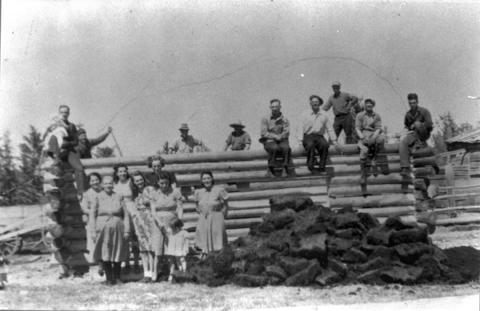Stories of immigration and settlement, homesteading and going to school in the countryside, church life and traditional remedies, folk songs and recipes of old fashioned doughnuts – these are some of the topics covered in the interviews in the University of Alberta Archives’ (UAA) Héritage Franco-Albertain fonds. The fonds consists of 15.4 m of textual records as well as numerous audio recordings generated by the “Projet Héritage Franco-Albertain.” This fonds was acquired by the University of Alberta Archives in 2019 from the Archives Saint-Jean which was previously housed at the University of Alberta’s Campus Saint-Jean.

(Provincial Archives of Alberta, A14950)

The “Projet Héritage Franco-Albertain” began in 1979 in association with Les Blés d’Or, a folk dance group from St. Paul, Alberta. Dedicated to preserving Franco-Albertan culture, the Héritage Franco-Albertain Project aimed to document expressions of French Canadian culture from across the province, including songs, dances, recipes, autobiographies, histories, and photographs. Most of the interviews were recorded in the early 1980s.
Over a hundred audio interviews were made accessible through the UAL audiovisual streaming platform as the Projet Héritage Franco-Albertain collection back in 2021. This year, we had an exciting opportunity to make 40+ additional interviews available online, many of them with detailed indexes and transcripts. Thanks to the generous support of Céleste Zurbrigg, the UAA was able to hire a student to focus on interviews conducted in Plamondon, AB and area. Céleste made this donation in honour of her parents, Lena Dubé and Albin Plamondon, who were active community members in Plamondon their entire lives. Olivia Gosselin, a third year undergraduate student in the Faculty of Education majoring in French as a Second Language, worked on the project under the supervision of Maryna Chernyavska, Digital Archivist at the UAA. She edited audio, created metadata for the Plamondon interviews, and transcribed several of them. After her project finished, the UAA continued processing the interviews and creating additional indexes and transcripts with the help of Julianna Swaby, a third year student at Faculté Saint-Jean majoring in Anthropology with a minor in Biology, and currently a summer student at the UAA.

We used the artificial intelligence (AI) tool, Whisper, from Open AI to create transcripts of audio which then had to be heavily edited. This helped us confirm what we already knew – that code switching is still really challenging for AI. We also learned that transcribing speech interspersed with singing confuses the software tool. However, using Whisper allowed us to create indexes and/or transcripts for about half of the Plamondon interviews, which wouldn’t have been possible within the timeframe we had, if such transcripts had to be human-generated from scratch. All of these are now accessible as part of the Projet Héritage Franco-Albertain collection and as a dedicated Projet Héritage Franco-Albertain – Plamondon & District Interviews playlist.
“Wow, this is an absolute treasure!” commented Céleste Zurbrigg after listening to the interview with her grandmother, Sylvia Dubé. She shared that another attendee at the Plamondon and District Museum open house in early July got emotional when she heard her grandmother’s voice, because her grandmother had passed away many years ago.
We are grateful to Céleste Zurbrigg for her financial support, as well as to everyone else who contributed to the project, especially to Lindsay Cline, a passionate audiovisual archives enthusiast and a former Archives Assistant at the UAA, and to the UAL Metadata Team, especially Luc Fagnan who greatly helped with his prior knowledge of this material, his French-language and metadata skills to make the Plamondon interviews accessible online – just in time for the announcement of the official launch of the new Plamondon and District Museum website. They have created a Digital Library section which includes a reference to the.Plamondon & District Interviews playlist on the UAL audiovisual digital curation platform Aviary.
Many thanks to Maryna Chernyavska, Digital Archivist Special Collections + Archives for authoring this article!
This content is licensed under a CC BY-NC-SA 4.0 Creative Commons licence.
